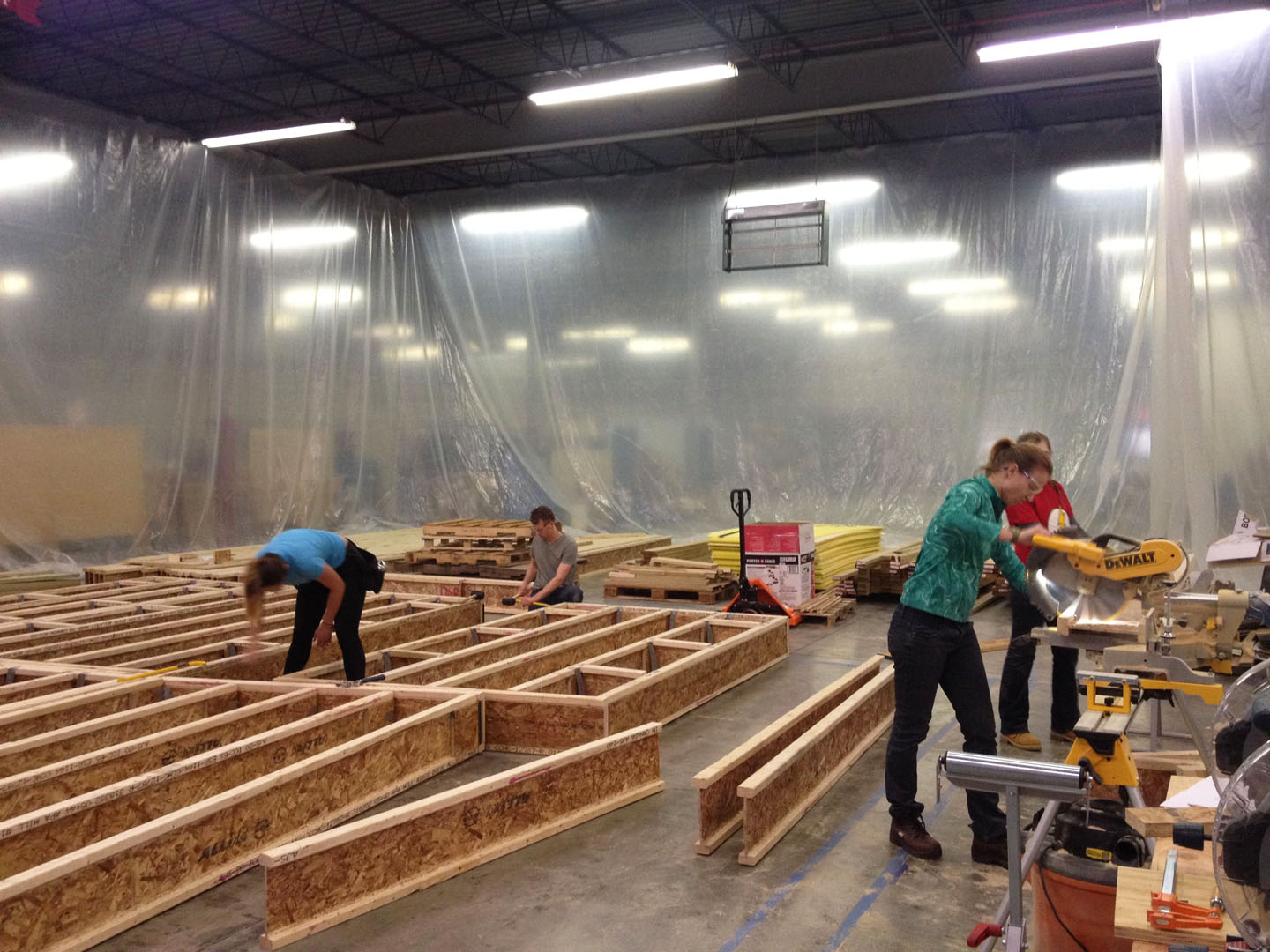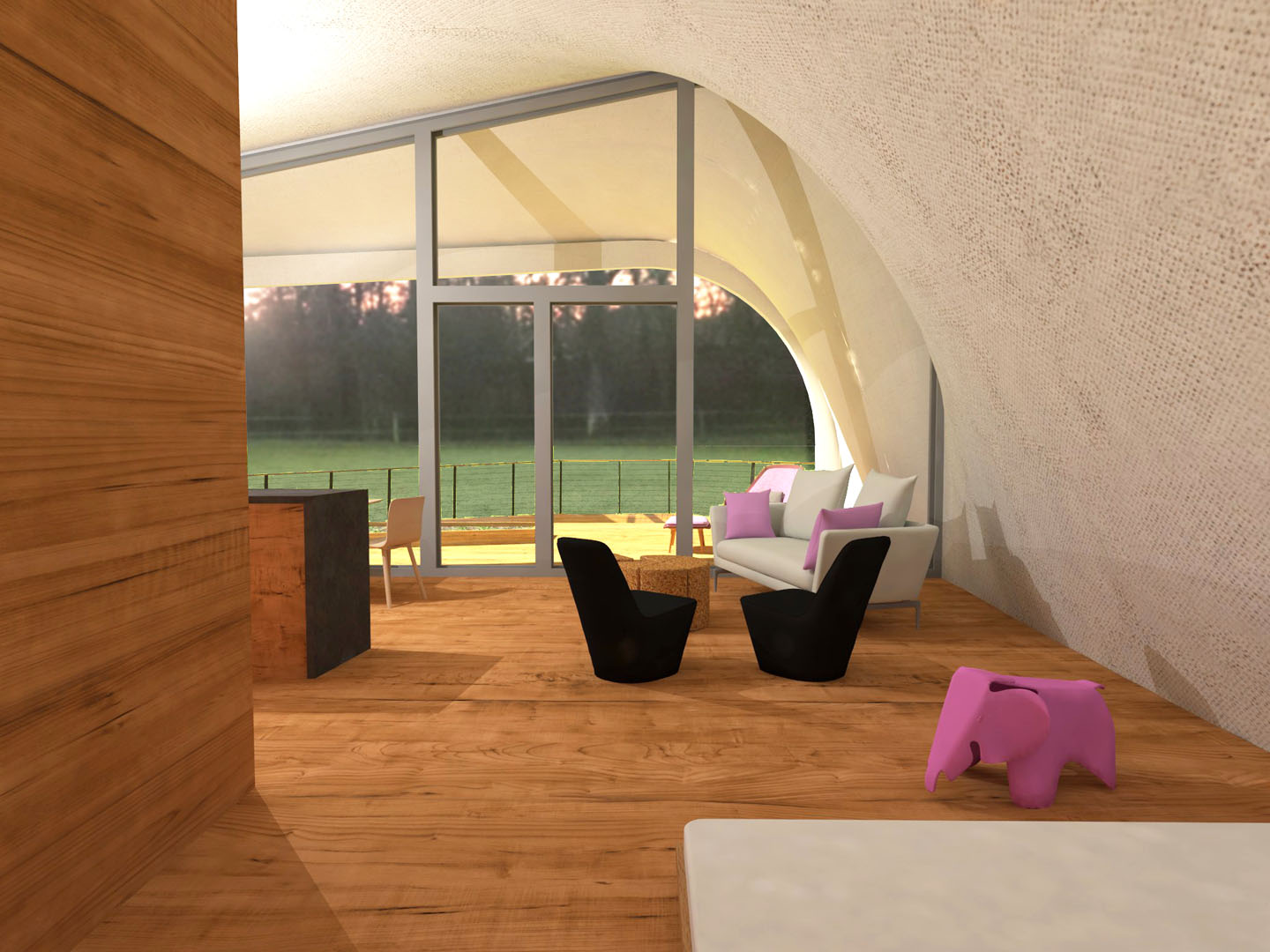PROVIDENCE, R.I. [Brown University] — After nearly two years of planning and design, it’s time to swing some hammers.
Students from RISD, Brown, and the University of Applied Sciences Erfurt, Germany, have started construction of Techstyle Haus, their entry in the 2014 Solar Decathlon Europe. The competition, which takes place in France this July, pits 20 collegiate teams against each other to see who can build the most innovative, efficient, and livable solar home.
“If you just build a solar house, you’re not going to win,” said Isabelle Lubin, a sophomore engineering student and one of the team members. “It’s about what you can do with it and how you can make a solar house different.”
Techstyle Haus will certainly be different. The outer shell of the 800-square-foot house will be made not of wood or metal, but with a flexible textile called Sheerfill. The material is often used for roofs of domed stadiums and other large structures, but has never before been used in residential construction. The soft shell won’t reduce the home’s efficiency, however. The students designed Techstyle Haus to meet the standard for a passive house, one that uses 90 percent less energy than a standard home. It will draw nearly all the power it needs from a flexible solar array attached to its curved textile roof.
“The most innovative aspect of the project is the textile wall assembly. Textiles are layered to create a high-performance exterior enclosure suitable for the Passive House Standard, while integrating textural interior textiles,” said Jonathan Knowles, associate professor of architecture and RISD project adviser on the Techstyle Haus. “In addition, we are utilizing integrated flexible solar photovoltaic cells and solar thermal units to harness energy.”

The team’s preliminary proposal was accepted into the Solar Decathlon in December 2012. Since then, the students have been refining their design and engineering the house’s key systems. Now, it’s time for Techstyle Haus to take shape.
The work is taking place in a Cranston warehouse, a section of which was donated to the team by Ximedica, a Rhode Island design firm specializing in medical devices. The first step in the construction is building the wooden platform on which the house will sit, along with the wooden deck that will surround it. Then comes construction and assembly of a mechanical core that contains the home’s kitchen area and bathroom as well as electrical, heating, and ventilation systems. The project will then move outside, where the students will erect the house’s five steel structural ribs and attach the textile shell.
“This is obviously a very exciting time for the team, who are seeing their designs take form at full scale,” said Derek Stein, professor of physics and a Brown faculty mentor for the project. “I’m most impressed with how the students have organized themselves. The management and communication system they spent over a year building is now proving its worth by guiding each student’s contribution into the whole.”
The students are currently working in the shadow of two wooden mock-ups of the house’s structural ribs. The 19-foot tall mock-ups are being used to refine the assembly process for the exterior wall and to help find the best way to attach insulation and interior textile walls. Figuring out the best way to attach the textile shell to the frame is crucial, and getting it right actually caused a slight delay in the start of construction.
“We’ve been really careful on this project to make sure all of our drawings are perfect and to analyze the way the fabric is going to behave,” Lubin said. “We thought that it would be better to start a little late and to build it right.”
From the beginning, safety has been in the front of the students’ minds. All team members completed a 10-hour OSHA safety course, and several safety leaders completed a 30-hour training.
“Everybody’s been really careful about being safe,” said Lubin, who is the team’s safety coordinator. “Everybody’s aware and looking out for one another.”

Companies from all over the world are working with the students as consultants. Providence-based Shawmut Design and Construction trained the students in construction safety and is helping with construction management. Saint Gobain, maker of the Sheerfill shell, and Birdair Inc., a company that built the sweeping fabric roof on the Denver International Airport, are consulting on the outer shell. Viessmann Manufacturing is helping with the HVAC system. Pazen, a German window maker, is supplying the large windows that will make up most of the house’s front and back walls. Schneider Electric, an international company based in France, is donating all of the house’s electrical equipment, including circuit breakers, energy monitors, and lighting controllers.
It’s a group of companies that don’t often work together, said Gareth Rose, a sophomore engineering student who is part of team’s construction management group.
“We’re doing things that have never been done before, [for example] trying to figure out how the fabric will meet the steel and the window frame at the same place,” Rose said. “One company is making the window frame and another is making the steel and another is making the textile. We try to have sponsor workshops where all the sponsors come and they get to talk to each other. It’s been fun watching them interact.”
If all goes as planned, the structure will be mostly assembled (minus the large windows, which are being made in Europe) by April. After testing to make sure all its systems are working as they’re supposed to, the house will be carefully dismantled and packed into shipping containers. Then it’s off to the competition site at the Palace of Versailles just outside Paris. Once at the competition site, the students will have nine days to reassemble the structure.
The students are confident that their novel design will help assembly in France go smoothly.
“We’re trying to invent a new way to build a house,” Rose said. “This idea that you can just pop up a skeleton and throw on a flexible shell — that’s new. The whole point is that it’s easy to prefabricate the shell and the structure so it goes together quickly and efficiently.”
The team is in for some long hours over the next few months, but they’re looking forward to it, Lubin said. “So far, it’s going great. It’s really exciting, especially as engineers, to finally be building something.”
